Jardin des plantes
| Jardin des plantes | |
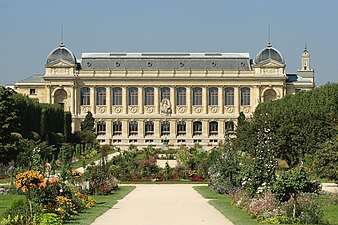 The exterior of the grande galerie de l'Évolution ('Gallery of Evolution'). Drawing plans by architect Louis-Jules André, 1889, when it still was named galerie de Zoologie ('Gallery of Zoology'). | |
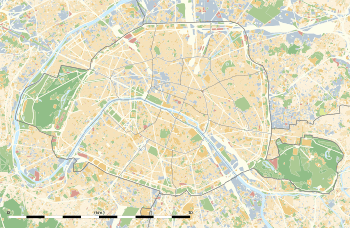 Location within Paris | |
| Established | 1635 |
|---|---|
| Location | Paris, France |
| Coordinates | 48°50′38″N 2°21′35″E / 48.84396°N 2.35960°E |
| Type | botanical garden |
| Visitors | 1,586,450[1] |
| Public transit access |
Jussieu Austerlitz |
| Muséum national d'histoire naturelle network | |
| |
The Jardin des plantes (French pronunciation: [ʒaʁdɛ̃ dɛ plɑ̃t]; French for 'Garden of the Plants'), also known as the jardin des plantes de Paris when distinguished from other jardins des plantes in other cities, is the main botanical garden in France. The term Jardin des plantes is the official name in the present day, but it is in fact an elliptical form of Jardin royal des plantes médicinales ('Royal Garden of the Medicinal Plants', which is related to the original purpose of the garden, back in the 17th century). Headquarters of the Muséum national d'histoire naturelle (the French National Museum of Natural History), the Jardin des plantes is situated in the 5ème arrondissement, Paris, on the left bank of the river Seine, and covers 28 hectares (280,000 m²).
Since March 24, 1993,[2] the entire garden and its contained buildings, archives, libraries, greenhouses, ménagerie (which is a zoo), works of art and specimens' collection are classified as a national historical landmark in France (labelled monument historique).
Garden plan
The grounds of the Jardin des plantes include four buildings containing exhibited specimens. These buildings are officially considered as museums following the French law (they are labelled musée de France) and the French Museum of Natural History calls them galeries (French for 'galleries'):
- The grande galerie de l'Évolution ('Gallery of Evolution') was inaugurated in 1889 as the galerie de Zoologie ('Gallery of Zoology'). In 1994 the gallery was renamed with its current name, grande galerie de l'Évolution, and its exhibited specimens were completely reorganised so that the visitor is oriented by the common thread of the evolution as the major subject treated by the gallery.
- The galerie de Minéralogie et de Géologie ('Gallery of Mineralogy and Geology'), a mineralogy museum, built as of 1833, inaugurated in 1837.
- The galerie de Paléontologie et d'Anatomie comparée ('Gallery of Paleontology and Comparative Anatomy'), a comparative anatomy museum in the ground floor and a paleontology museum in the first and second floors. The building was inaugurated in 1898.
- The galerie de Botanique ('Gallery of Botany'), inaugurated in 1935 thanks to funds provided by the Rockefeller Foundation, contains botany laboratories and the French Muséum's National Herbarium (the biggest in the world with a collection of almost 8 million samples of plants). The building also contains a small permanent exhibition about botany.
In addition to the gardens and the galleries, there is also a small zoo, the ménagerie du Jardin des plantes, founded in 1795 by Bernardin de Saint-Pierre from animals of the ménagerie royale de Versailles, the menagerie at Versailles, dismantled during the French Revolution.
The Jardin des plantes maintains a botanical school, which trains botanists, constructs demonstration gardens, and exchanges seeds to maintain biotic diversity. About 4,500 plants are arranged by family on a one hectare (10,000 m²) plot. Three hectares are devoted to horticultural displays of decorative plants. An Alpine garden has 3,000 species with world-wide representation. Specialized buildings, such as a large Art Deco winter garden, and Mexican and Australian hothouses display regional plants, not native to France. The Rose Garden, created in 1990, has hundreds of species of roses and rose trees.
History
Founded in 1626, the garden was not planted by Guy de La Brosse, Louis XIII's physician, until 1635 as a medicinal herb garden. It was originally known as the Jardin du Roi. In 1640 it opened to the public. After a period of decline, Jean-Baptiste Colbert took administrative control of the gardens. Dr. Guy-Crescent Fagon was appointed in 1693, and he surrounded himself with a team of experienced botanists, including Joseph Pitton de Tournefort, Antoine de Jussieu, Antoine Laurent de Jussieu and his son Adrien-Henri.
The holdings include 6,963 specimens of the herbarium collection of Joseph Tournefort, donated on his death to the Jardin du Roi.[3]
The Comte de Buffon became the curator in 1739 and he expanded the gardens greatly, adding a maze, the labyrinth, which remains today. In 1792 the Royal Menagerie was moved to the gardens from Versailles.
Access
| Located near the Métro stations: Quai de la Rapée, Jussieu, Place Monge and Gare d'Austerlitz. |
See also
Gallery
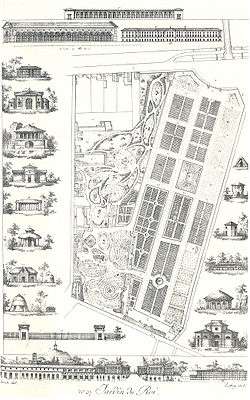 Plan of the Jardin des plantes from 1820
Plan of the Jardin des plantes from 1820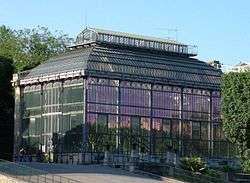 The Nouvelle Calédonie's Hothouse built (1834–36) by Charles Rohault de Fleury, an early example of French glass and metal architecture
The Nouvelle Calédonie's Hothouse built (1834–36) by Charles Rohault de Fleury, an early example of French glass and metal architecture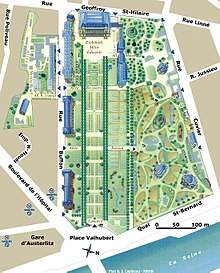 Map of the Jardin des plantes
Map of the Jardin des plantes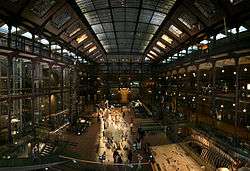 Inside the grande galerie de l'Évolution
Inside the grande galerie de l'Évolution A fruiting tree of Trifoliate oranges
A fruiting tree of Trifoliate oranges
References
- ↑ "Tourism in Paris: Key Figures 2016". Paris Visitors and Convention Bureau. p. 19. Retrieved 24 March 2018.
- ↑ Jardin des plantes et Muséum national d'histoire naturelle, note number PA00088482, base Mérimée, French Ministry of Culture
- ↑ "Herbarium J.P. de Tournefort (1656-1708)". brill.com. Retrieved 29 September 2014.
External links
| Wikimedia Commons has media related to Jardin des plantes de Paris. |